SEO
How to Do a SERP Analysis

SERP analysis is a process that helps you determine if and how you can rank for a keyword and whether the effort is worth the reward.
It’s important because not all keywords are created equal. Some are harder to rank for than others, so you must choose wisely.
In this guide, you’ll learn how to analyze a SERP to see if it’s crackable.
Let’s get started.
The first step of a SERP analysis is to get a rough sense of the traffic opportunity and ranking difficulty opportunity.
To do this, we can use two of Ahrefs’ core metrics: Keyword Difficulty and Traffic Potential.
- Keyword Difficulty (KD) estimates how hard it will be to rank on the first page of Google for a keyword on a scale from 0 to 100.
- Traffic Potential (TP) is the total estimated monthly search traffic to the top-ranking page for a keyword.
Using these two metrics, we will be able to get a top-level overview of the SERP and determine whether it’s worth further investigation.
Let’s use Ahrefs’ Keywords Explorer to get a quick, high-level view of the keyword “when were dogs domesticated.”

So what exactly is the overview showing us?
We can see the keyword “when were dogs domesticated” has a super hard KD of 73 but a low TP of 3.2K.
At first glance, this query doesn’t appear to be worth the effort. But it may warrant further investigation if this topic is lucrative for your business.
With a super hard KD of 73, Ahrefs estimates that we will need ~235 links to rank in the top 10 for this SERP, which will require a fair amount of resources to compete.
Generally speaking, it is better to look for low-KD and high-TP queries, where possible.
To better understand the effort-to-reward ratio for this query, and any others, we can plot the effort-to-reward ratio in an XY graph:
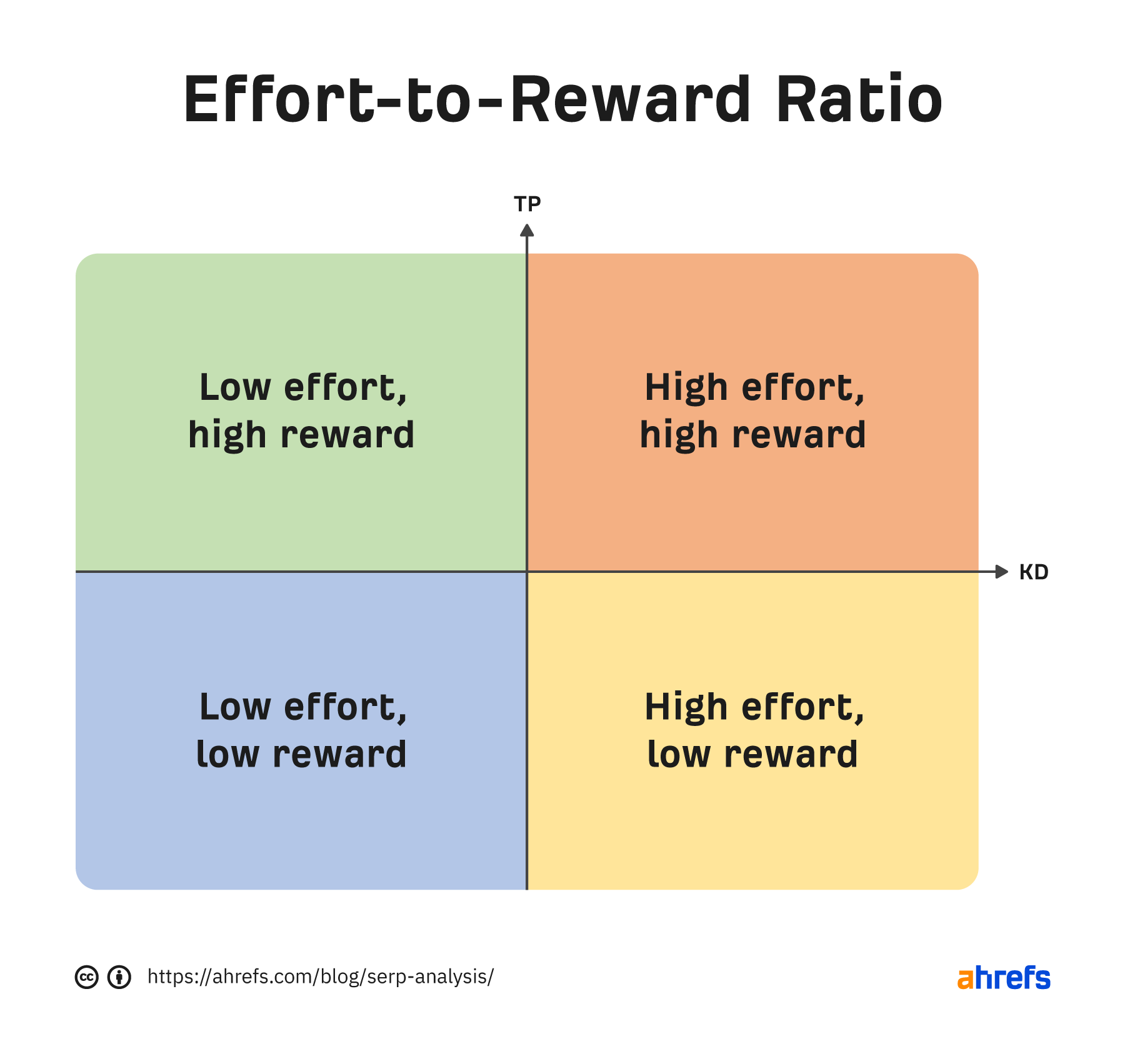
- Top left: Golden opportunities (low investment, high reward).
- Top right: Long-term opportunities (high investment, high reward).
- Bottom left: Possible opportunities (low rewards, so effort might not be worth it).
- Bottom right: Try to avoid (unless it’s a highly lucrative topic for your business).
Our query for “when were dogs domesticated” falls into the “high effort, low reward” quadrant, so it may not be worth the effort.
We are looking for a query that falls in the top left-hand section. In most cases, these will be the golden keyword opportunities.
Avoid queries that fall into the bottom right section where possible unless it is particularly lucrative for your business.
Let’s try to find a search with more opportunity.
Let’s plug in “how to leash train a dog” into Ahrefs’ Keywords Explorer and see if this keyword has better metrics.

We can see that this query has a medium KD of 18 but a much higher TP of 24K. Great!
We can see that this search has a much better effort-to-reward ratio than our previous query, so let’s scroll down the page in Keywords Explorer to the SERP overview and investigate if (and how) we can rank.
Now that we have completed our top-level overview, we can consider other factors using the SERP overview in Ahrefs’ Keywords Explorer.
We should consider four key elements in our SERP analysis when investigating the ranking difficulty:
1. Domain Rating (DR)
DR is one of Ahrefs’ most widely used metrics in SEO. It shows the relative strength of a website’s backlink profile on a scale from 0 to 100.
It’s not a Google ranking factor, but there are a couple of reasons why it can be easier for high-DR sites to rank on Google:
- They can boost a page’s strength with internal links – High-DR sites have lots of strong pages. They can funnel some of this strength to specific pages with internal links.
- They are often trusted brands – People may prefer to click these results on the SERPs. They may also have more topical authority, which may help.
These reasons explain why 64.9% of SEOs pay attention to DR when analyzing their chances to rank:
While it’s certainly possible to outrank a higher DR site, a good rule of thumb is to look for pages ranking in the top 10 with the same DR as you or lower. By doing this, we can maximize our chances of appearing on the SERP.
If we return to our previous query “how to leash train a dog” and look at the SERP overview, we can see that the first result comes from a DR 90 site.
Even with a high-DR site, this looks hard to beat.
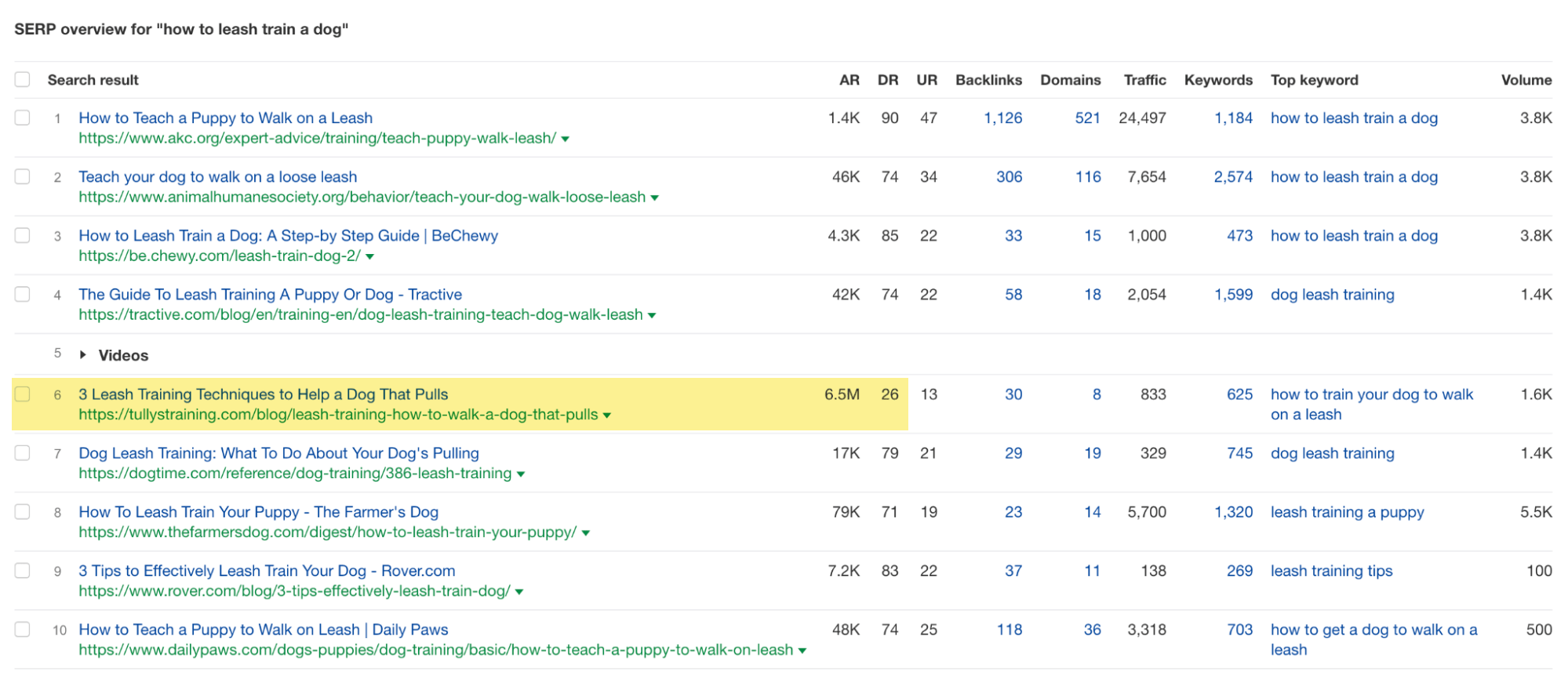
- Scanning down the DR column, we can see that 8 out of 10 sites have a DR of 70+, so we could potentially be on the back foot from the start with this query.
- Jumping to the sixth result, we can see that it has a DR of 26, which suggests that this SERP is crackable, at least in terms of DR.

Finding outliers like this DR 26 site is what we need to be focusing on at this stage. It can mean that ranking on this SERP with a ≤ 70 DR site is possible.
Assuming that we don’t have a DR 70+ site, our hopes of ranking will most likely rest on equalling the ranking of the DR 26 site.
It is worth noting that the traffic this site receives is estimated to be around 833, which is a lot lower than our original estimated 24K TP.
With these revised figures, we need to reevaluate whether the effort is worth the reward at this stage. That depends on our website’s authority, our risk appetite, and the resources available.
Although DR plays an important initial role in our SERP analysis, there are other factors that we should consider as well, such as links.
2. Links
If you ask an SEO what the top Google ranking factors are, chances are they will mention “backlinks” in their reply.
But what exactly is a backlink? Simply put, backlinks are clickable links from one website to another.

Backlinks are also highly important for ranking on Google, as they are one of eight confirmed ranking factors.
We saw in step #1 that KD can give us a broad indication of how many links we will need to rank, but actual link numbers will vary from site to site.
Let’s return to our query for “how to leash train a dog” in the SERP overview and take a closer look at the links.
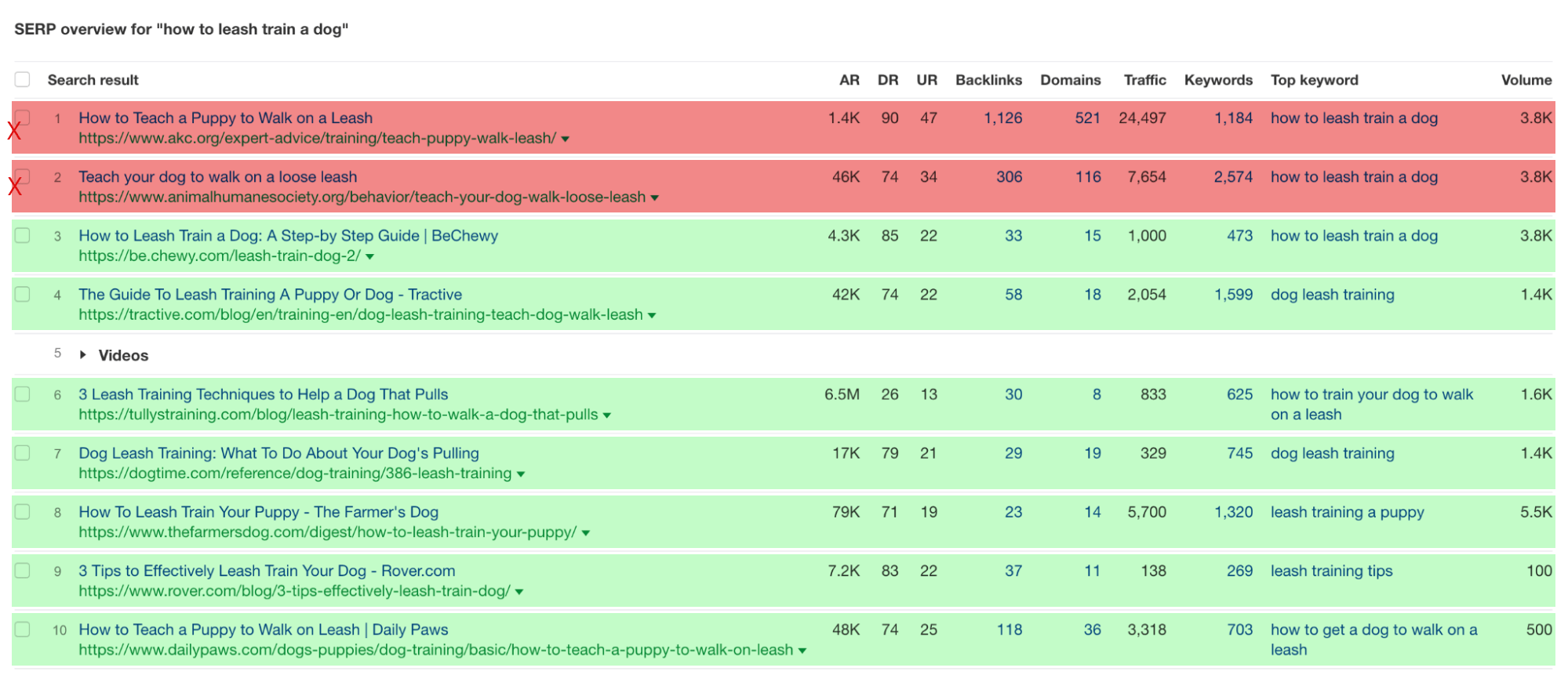
- Looking at the Domains column in the above image, we can see that the first result has 521 referring domains. Unless we can acquire over 521 referring domains, we should rule out the possibility of outranking this result.
- The second result has 116 domains. Again, this seems relatively high, so we should probably rule out outranking this result too.
- Positions #3–10, however, have ≤ 36 domains each, which is where the most opportunities lie on this SERP.
We can see from this link analysis that the lower end of the SERP is much easier to crack—at least in terms of links.
If we hone in on the sixth result, we can see that this site only has eight domains.

Acquiring more than eight domains should be achievable for most businesses, so this could be a great opportunity.
We only need to be aware that the estimated traffic for the sixth result is much lower than our initial TP estimate of 24K and is now 851.
Looking at the rest of the SERP’s traffic, we can see that rather than gradually declining, the eighth and 10th results have more impressive estimated traffic, 5,895 and 3,643, respectively.
This may mean that the estimated traffic opportunity may not be as low as 851, but it can vary depending on our exact position.
So far, just using DR and links, we have seen how feasible it will be for us to rank on this SERP. We can see that the lower half of the SERP (from positions #6–10) is most achievable at this stage.
Now we will need to consider the role of search intent on the SERP.
3. Search intent
Search intent is used to describe the primary reason for an online search. In other words, it indicates why the user typed their query into the search engine in the first place.
But what does search intent mean in terms of our SERP analysis?
In a nutshell: Our webpage needs to provide the best answer for the query to rank well on the SERP. Identifying the dominant search intent on the SERP can help determine how or if we will compete.
Most content on the internet falls into the categories below and, for our SERP analysis, it makes sense to use this categorization:
- Blog posts
- Category pages
- Product pages
- Landing pages
- Videos
Let’s use Ahrefs’ own keywords to explore this concept in more detail.
Say we have a website that we want to rank for “backlink checker,” and we have written a blog post targeting that query.
This alone will not enable us to rank for this query, as the intent of this search is strongly aligned toward SEO tool companies with big backlink databases—like Ahrefs. For these types of websites, the backlink checker is likely to be one of their main product pages.
If you thought of it, why would you click on a result for “backlink checker” that didn’t have a backlink checker product?
You probably wouldn’t.
This rules out the possibility of targeting this keyword for the average website creating a simple blog post on this topic.
Let’s consider another more visual example using Ahrefs’ Keywords Explorer. Let’s plug in the keyword “how to draw a picasso face” and scroll down to the SERP overview.
With this query, we can see that 4 out of the top 6 results on this SERP are video-based. Therefore, we can see that the search intent is focused on video content.
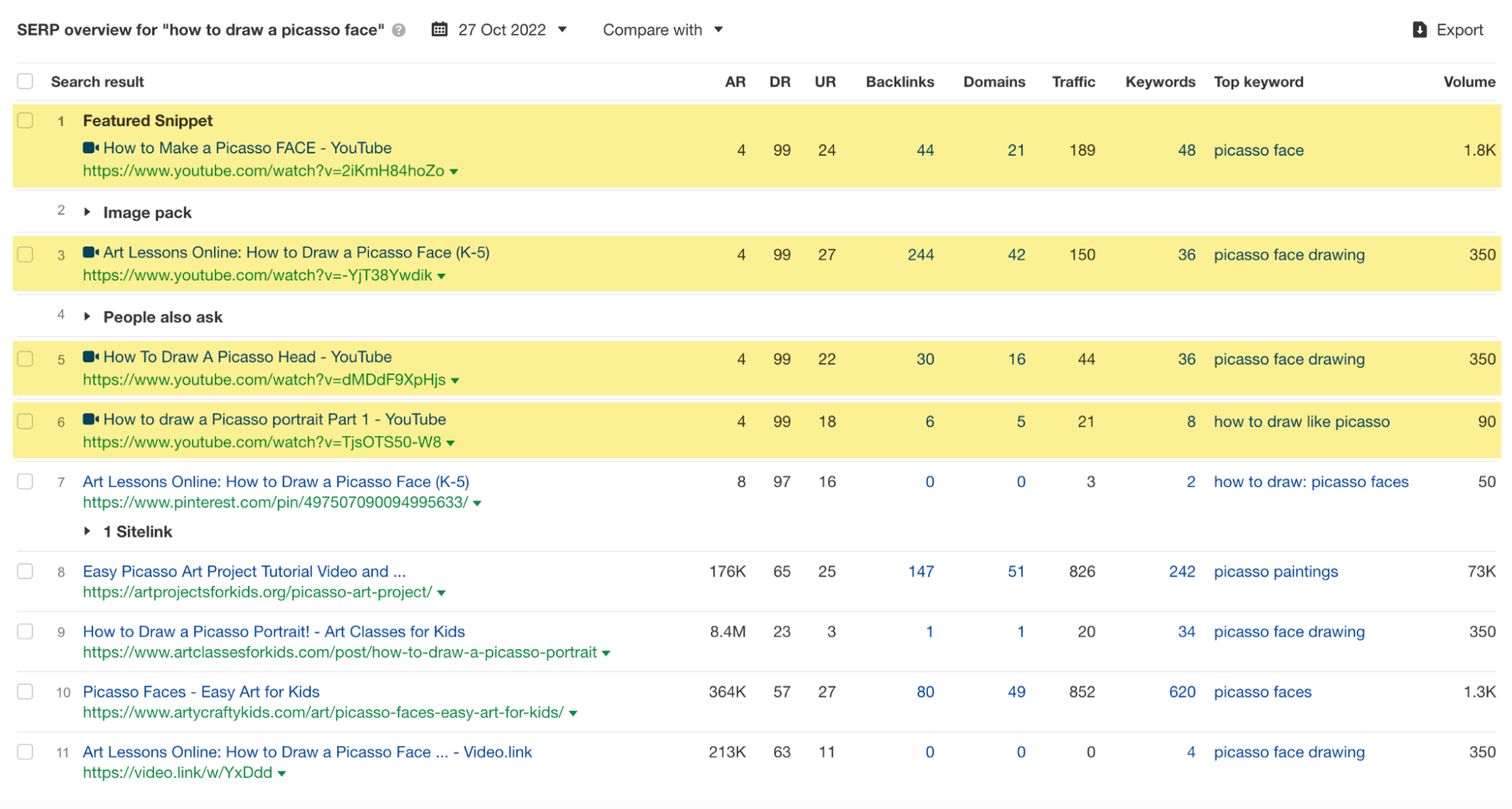
Because this format of content is so dominant at the top of the SERP, it will likely be tough to rank near the top of this SERP unless we create video content ourselves.
Returning to the SERP overview for our “how to leash train a dog” search query, we can see that the majority of the articles here are blog posts, but the fifth result is a video SERP feature.
This indicates that, at least for some searches, searchers are looking for video guides rather than blog posts about this topic.
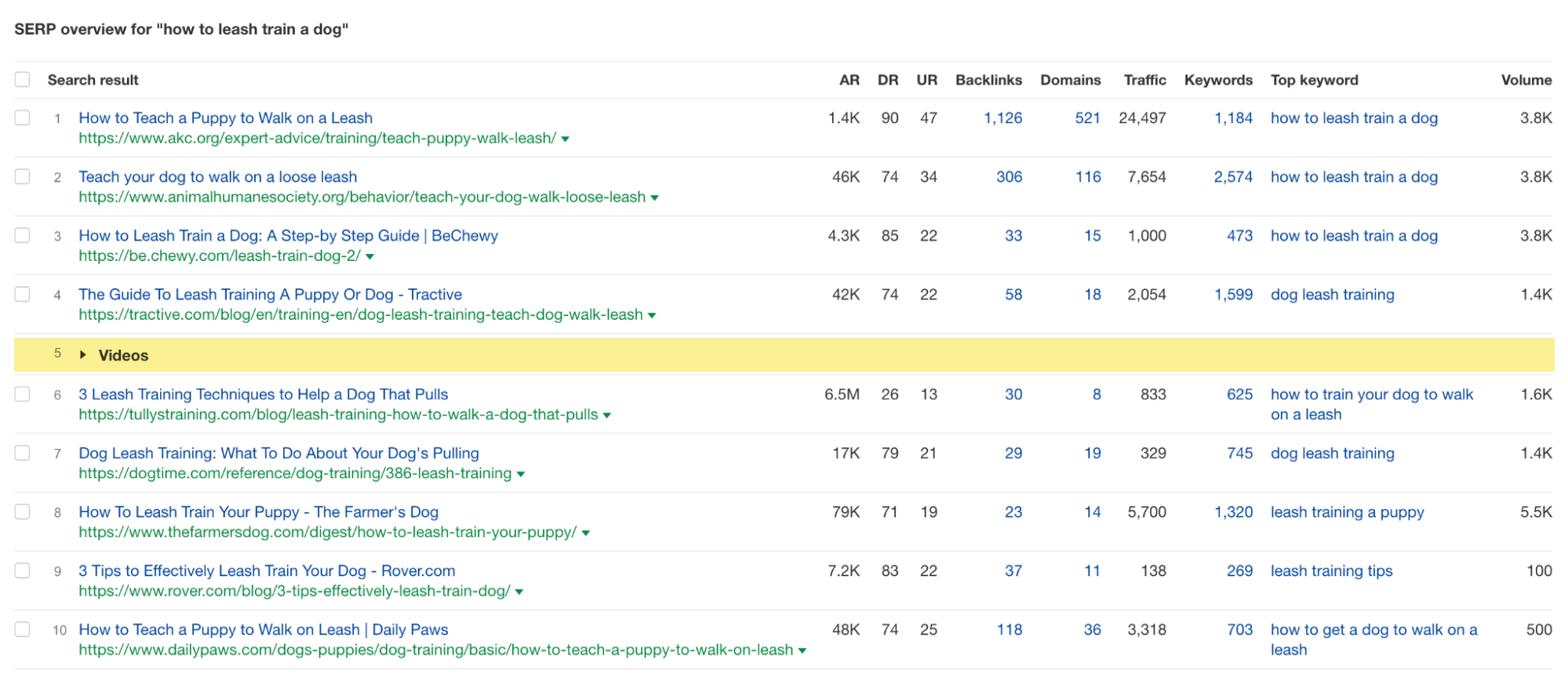
With this type of mixed search intent, it is best to create content in both formats, assuming you have the expertise and resources to compete. This will likely increase the chances of appearing on the SERP for this particular keyword.
In summary, we have seen how analyzing search intent can help inform our SERP strategy and determine if and how we will compete.
Let’s now take a look at content quality.
4. Content quality
It’s worth being aware that the standard of content Google expects can be much higher for certain topics.
For example, in a Your Money or Your Life (YMYL) topic, such as medical advice, you likely need to provide content created or reviewed by doctors to compete on the SERP.
Google defines YMYL topics as the following:

Unless you have the resources to compete on these types of SERPs, then it is a good idea to stay clear of them.
Even in non-YMYL topics, such as product reviews, there are sites like Wirecutter independently reviewing thousands of products every year with great success. So it’s not just YMYL topics that have extremely high-quality content.

Wirecutter now has the backing of The New York Times, so it has tremendous resources at hand.
Looking at its website, it typically updates or publishes around 10 articles per day, and this is despite its reviews taking “weeks or months of research” to complete.
So how do high-quality sites like Wirecutter impact our SERP analysis?
Simply put, if there is a website that has high-quality content within the SERP, then you should consider whether you have the resources to compete and outrank them.
The final step of our SERP analysis is to check for any other opportunities. One of the biggest opportunities you can take advantage of is SERP features.
Google seems to have hinted it as one of its priorities for search as far back as 2007. According to then-representative Marissa Mayer:
We [Google] want to help you find the very best answer, even if you don’t know where to look.
But what exactly is a SERP feature, and how can we identify it?
A SERP feature is any result on the SERPs that is not a traditional organic search result.
In brief, these are some of the most common SERP features and their basic requirements:
- Featured snippets – Provide a concise answer to a query.
- Video carousels – Create a YouTube video on the topic.
- Image packs – Provide a relevant image of what people are looking for.
- Top stories – Publish relevant news stories on the topic.
- People Also Ask – Answer a related question on the topic.
Using Ahrefs’ Site Explorer, we can see a list of current SERP features in the Organic keywords report by entering any website into the search bar and then clicking on the SERP features filter.
In the example below, I have used ahrefs.com.

Filtering results by specific SERP features can be useful for competitor analysis or simply understanding which SERP features your website ranks for.
So what do SERP features look like in the wild?
Let’s take a look at a featured snippet for “what are cats whiskers for” in Google search.

As we can see above, appearing in a featured snippet will mean you get more SERP real estate than a standard organic listing and will also mean that the result appears at the top of the search results.
This is why SERP features are considered by some SEOs as the cheat codes for SEO. They can also potentially drive more traffic than your average organic result.
If we return to our previous example of “how to leash train a dog,” we can see that the SERP overview has identified the fifth result on this SERP as a video SERP feature.
Let’s click on the caret next to Videos to expand this result.
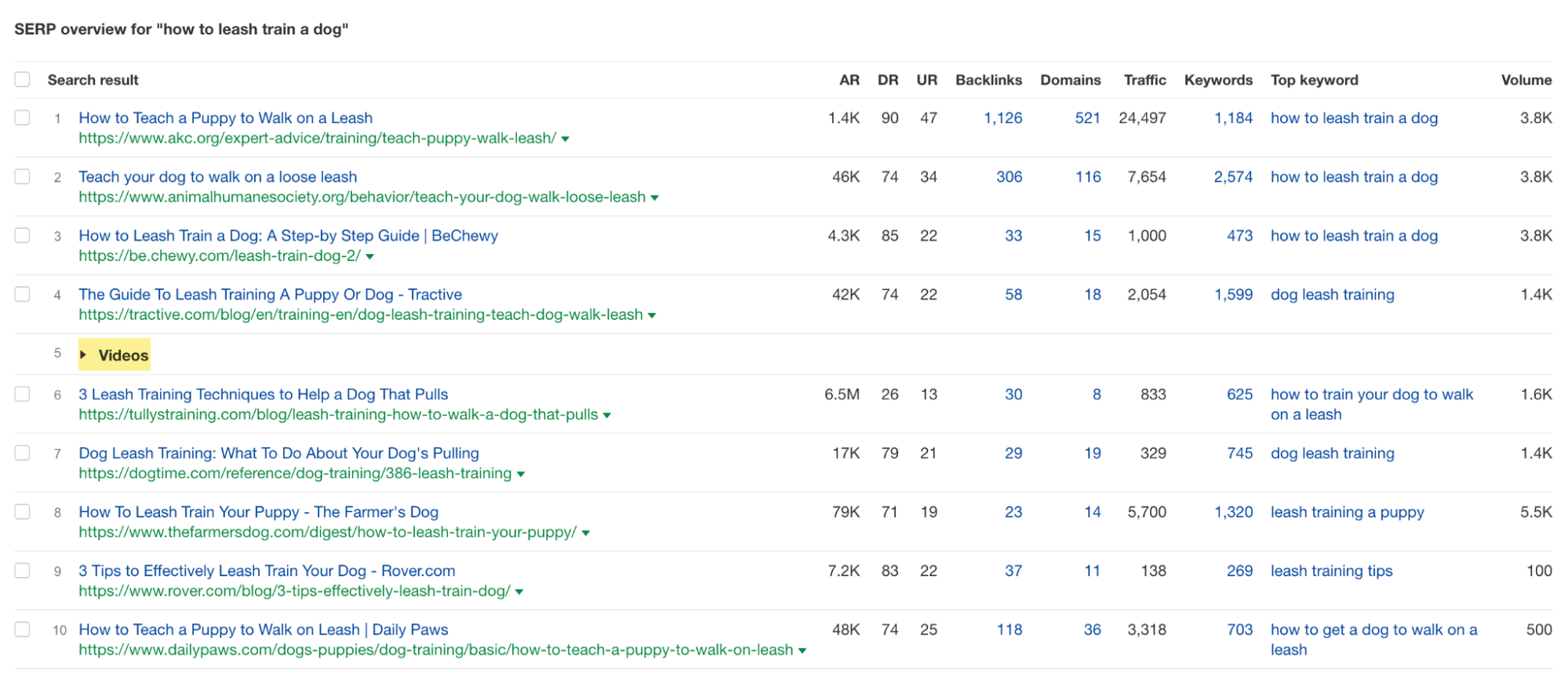
Once we click on the caret, we can see the expanded result.

There are three videos in the carousel from 2016, 2017, and 2021. If we had the resources to create video content for this query, creating a more up-to-date, high-quality video could be a valuable shortcut to ranking well on this SERP.
Assuming we managed to rank a video in the fifth position, this would leapfrog the DR 26 website we looked at earlier in the sixth position.
If you created a blog post and a YouTube video targeting this search, you could acquire traffic from two sources rather than just one.
In summary, targeting SERP features is worth your time if you have the resources available. Winning SERP features allows us to acquire more SERP real estate instead of just appearing for a single organic result for a search query.
Final thoughts
Conducting a SERP analysis may sound daunting at first, but Keywords Explorer makes it easy by giving you an overview of the key metrics you need to consider.
After that, it’s just a case of following the process and asking yourself:
- Can you provide a better answer to a keyword query than what is on the current SERP?
- Can you create higher-quality content than the top result for the query?
- Do you have sufficient resources to create the content?
- Are there any SERP features you can target to win more SERP real estate?
If the answer is “yes” to most of the above questions, you should have a decent chance of cracking the SERP.
What’s your experience with SERP analysis? Got more questions? Ping me on Twitter. 🙂
SEO
Measuring Content Impact Across The Customer Journey

Understanding the impact of your content at every touchpoint of the customer journey is essential – but that’s easier said than done. From attracting potential leads to nurturing them into loyal customers, there are many touchpoints to look into.
So how do you identify and take advantage of these opportunities for growth?
Watch this on-demand webinar and learn a comprehensive approach for measuring the value of your content initiatives, so you can optimize resource allocation for maximum impact.
You’ll learn:
- Fresh methods for measuring your content’s impact.
- Fascinating insights using first-touch attribution, and how it differs from the usual last-touch perspective.
- Ways to persuade decision-makers to invest in more content by showcasing its value convincingly.
With Bill Franklin and Oliver Tani of DAC Group, we unravel the nuances of attribution modeling, emphasizing the significance of layering first-touch and last-touch attribution within your measurement strategy.
Check out these insights to help you craft compelling content tailored to each stage, using an approach rooted in first-hand experience to ensure your content resonates.
Whether you’re a seasoned marketer or new to content measurement, this webinar promises valuable insights and actionable tactics to elevate your SEO game and optimize your content initiatives for success.
View the slides below or check out the full webinar for all the details.
SEO
How to Find and Use Competitor Keywords

Competitor keywords are the keywords your rivals rank for in Google’s search results. They may rank organically or pay for Google Ads to rank in the paid results.
Knowing your competitors’ keywords is the easiest form of keyword research. If your competitors rank for or target particular keywords, it might be worth it for you to target them, too.
There is no way to see your competitors’ keywords without a tool like Ahrefs, which has a database of keywords and the sites that rank for them. As far as we know, Ahrefs has the biggest database of these keywords.
How to find all the keywords your competitor ranks for
- Go to Ahrefs’ Site Explorer
- Enter your competitor’s domain
- Go to the Organic keywords report
The report is sorted by traffic to show you the keywords sending your competitor the most visits. For example, Mailchimp gets most of its organic traffic from the keyword “mailchimp.”


Since you’re unlikely to rank for your competitor’s brand, you might want to exclude branded keywords from the report. You can do this by adding a Keyword > Doesn’t contain filter. In this example, we’ll filter out keywords containing “mailchimp” or any potential misspellings:


If you’re a new brand competing with one that’s established, you might also want to look for popular low-difficulty keywords. You can do this by setting the Volume filter to a minimum of 500 and the KD filter to a maximum of 10.


How to find keywords your competitor ranks for, but you don’t
- Go to Competitive Analysis
- Enter your domain in the This target doesn’t rank for section
- Enter your competitor’s domain in the But these competitors do section


Hit “Show keyword opportunities,” and you’ll see all the keywords your competitor ranks for, but you don’t.


You can also add a Volume and KD filter to find popular, low-difficulty keywords in this report.


How to find keywords multiple competitors rank for, but you don’t
- Go to Competitive Analysis
- Enter your domain in the This target doesn’t rank for section
- Enter the domains of multiple competitors in the But these competitors do section


You’ll see all the keywords that at least one of these competitors ranks for, but you don’t.


You can also narrow the list down to keywords that all competitors rank for. Click on the Competitors’ positions filter and choose All 3 competitors:


- Go to Ahrefs’ Site Explorer
- Enter your competitor’s domain
- Go to the Paid keywords report


This report shows you the keywords your competitors are targeting via Google Ads.
Since your competitor is paying for traffic from these keywords, it may indicate that they’re profitable for them—and could be for you, too.
You know what keywords your competitors are ranking for or bidding on. But what do you do with them? There are basically three options.
1. Create pages to target these keywords
You can only rank for keywords if you have content about them. So, the most straightforward thing you can do for competitors’ keywords you want to rank for is to create pages to target them.
However, before you do this, it’s worth clustering your competitor’s keywords by Parent Topic. This will group keywords that mean the same or similar things so you can target them all with one page.
Here’s how to do that:
- Export your competitor’s keywords, either from the Organic Keywords or Content Gap report
- Paste them into Keywords Explorer
- Click the “Clusters by Parent Topic” tab


For example, MailChimp ranks for keywords like “what is digital marketing” and “digital marketing definition.” These and many others get clustered under the Parent Topic of “digital marketing” because people searching for them are all looking for the same thing: a definition of digital marketing. You only need to create one page to potentially rank for all these keywords.


2. Optimize existing content by filling subtopics
You don’t always need to create new content to rank for competitors’ keywords. Sometimes, you can optimize the content you already have to rank for them.
How do you know which keywords you can do this for? Try this:
- Export your competitor’s keywords
- Paste them into Keywords Explorer
- Click the “Clusters by Parent Topic” tab
- Look for Parent Topics you already have content about
For example, if we analyze our competitor, we can see that seven keywords they rank for fall under the Parent Topic of “press release template.”


If we search our site, we see that we already have a page about this topic.


If we click the caret and check the keywords in the cluster, we see keywords like “press release example” and “press release format.”


To rank for the keywords in the cluster, we can probably optimize the page we already have by adding sections about the subtopics of “press release examples” and “press release format.”
3. Target these keywords with Google Ads
Paid keywords are the simplest—look through the report and see if there are any relevant keywords you might want to target, too.
For example, Mailchimp is bidding for the keyword “how to create a newsletter.”


If you’re ConvertKit, you may also want to target this keyword since it’s relevant.
If you decide to target the same keyword via Google Ads, you can hover over the magnifying glass to see the ads your competitor is using.


You can also see the landing page your competitor directs ad traffic to under the URL column.


Learn more
Check out more tutorials on how to do competitor keyword analysis:
SEO
Google Confirms Links Are Not That Important

Google’s Gary Illyes confirmed at a recent search marketing conference that Google needs very few links, adding to the growing body of evidence that publishers need to focus on other factors. Gary tweeted confirmation that he indeed say those words.
Background Of Links For Ranking
Links were discovered in the late 1990’s to be a good signal for search engines to use for validating how authoritative a website is and then Google discovered soon after that anchor text could be used to provide semantic signals about what a webpage was about.
One of the most important research papers was Authoritative Sources in a Hyperlinked Environment by Jon M. Kleinberg, published around 1998 (link to research paper at the end of the article). The main discovery of this research paper is that there is too many web pages and there was no objective way to filter search results for quality in order to rank web pages for a subjective idea of relevance.
The author of the research paper discovered that links could be used as an objective filter for authoritativeness.
Kleinberg wrote:
“To provide effective search methods under these conditions, one needs a way to filter, from among a huge collection of relevant pages, a small set of the most “authoritative” or ‘definitive’ ones.”
This is the most influential research paper on links because it kick-started more research on ways to use links beyond as an authority metric but as a subjective metric for relevance.
Objective is something factual. Subjective is something that’s closer to an opinion. The founders of Google discovered how to use the subjective opinions of the Internet as a relevance metric for what to rank in the search results.
What Larry Page and Sergey Brin discovered and shared in their research paper (The Anatomy of a Large-Scale Hypertextual Web Search Engine – link at end of this article) was that it was possible to harness the power of anchor text to determine the subjective opinion of relevance from actual humans. It was essentially crowdsourcing the opinions of millions of website expressed through the link structure between each webpage.
What Did Gary Illyes Say About Links In 2024?
At a recent search conference in Bulgaria, Google’s Gary Illyes made a comment about how Google doesn’t really need that many links and how Google has made links less important.
Patrick Stox tweeted about what he heard at the search conference:
” ‘We need very few links to rank pages… Over the years we’ve made links less important.’ @methode #serpconf2024″
Google’s Gary Illyes tweeted a confirmation of that statement:
“I shouldn’t have said that… I definitely shouldn’t have said that”
Why Links Matter Less
The initial state of anchor text when Google first used links for ranking purposes was absolutely non-spammy, which is why it was so useful. Hyperlinks were primarily used as a way to send traffic from one website to another website.
But by 2004 or 2005 Google was using statistical analysis to detect manipulated links, then around 2004 “powered-by” links in website footers stopped passing anchor text value, and by 2006 links close to the words “advertising” stopped passing link value, links from directories stopped passing ranking value and by 2012 Google deployed a massive link algorithm called Penguin that destroyed the rankings of likely millions of websites, many of which were using guest posting.
The link signal eventually became so bad that Google decided in 2019 to selectively use nofollow links for ranking purposes. Google’s Gary Illyes confirmed that the change to nofollow was made because of the link signal.
Google Explicitly Confirms That Links Matter Less
In 2023 Google’s Gary Illyes shared at a PubCon Austin that links were not even in the top 3 of ranking factors. Then in March 2024, coinciding with the March 2024 Core Algorithm Update, Google updated their spam policies documentation to downplay the importance of links for ranking purposes.
The documentation previously said:
“Google uses links as an important factor in determining the relevancy of web pages.”
The update to the documentation that mentioned links was updated to remove the word important.
Links are not just listed as just another factor:
“Google uses links as a factor in determining the relevancy of web pages.”
At the beginning of April Google’s John Mueller advised that there are more useful SEO activities to engage on than links.
Mueller explained:
“There are more important things for websites nowadays, and over-focusing on links will often result in you wasting your time doing things that don’t make your website better overall”
Finally, Gary Illyes explicitly said that Google needs very few links to rank webpages and confirmed it.
I shouldn’t have said that… I definitely shouldn’t have said that
— Gary 鯨理/경리 Illyes (so official, trust me) (@methode) April 19, 2024
Why Google Doesn’t Need Links
The reason why Google doesn’t need many links is likely because of the extent of AI and natural language undertanding that Google uses in their algorithms. Google must be highly confident in its algorithm to be able to explicitly say that they don’t need it.
Way back when Google implemented the nofollow into the algorithm there were many link builders who sold comment spam links who continued to lie that comment spam still worked. As someone who started link building at the very beginning of modern SEO (I was the moderator of the link building forum at the #1 SEO forum of that time), I can say with confidence that links have stopped playing much of a role in rankings beginning several years ago, which is why I stopped about five or six years ago.
Read the research papers
Authoritative Sources in a Hyperlinked Environment – Jon M. Kleinberg (PDF)
The Anatomy of a Large-Scale Hypertextual Web Search Engine
Featured Image by Shutterstock/RYO Alexandre
-

 PPC4 days ago
PPC4 days ago19 Best SEO Tools in 2024 (For Every Use Case)
-

 MARKETING7 days ago
MARKETING7 days agoWill Google Buy HubSpot? | Content Marketing Institute
-
SEARCHENGINES7 days ago
Daily Search Forum Recap: April 16, 2024
-

 SEO7 days ago
SEO7 days agoGoogle Clarifies Vacation Rental Structured Data
-

 MARKETING6 days ago
MARKETING6 days agoStreamlining Processes for Increased Efficiency and Results
-
SEARCHENGINES6 days ago
Daily Search Forum Recap: April 17, 2024
-

 SEO6 days ago
SEO6 days agoAn In-Depth Guide And Best Practices For Mobile SEO
-

 PPC6 days ago
PPC6 days ago97 Marvelous May Content Ideas for Blog Posts, Videos, & More















You must be logged in to post a comment Login